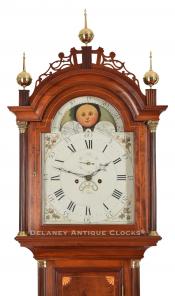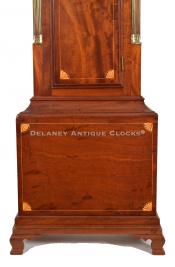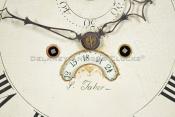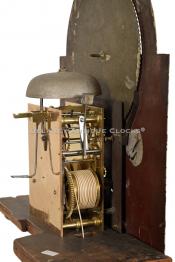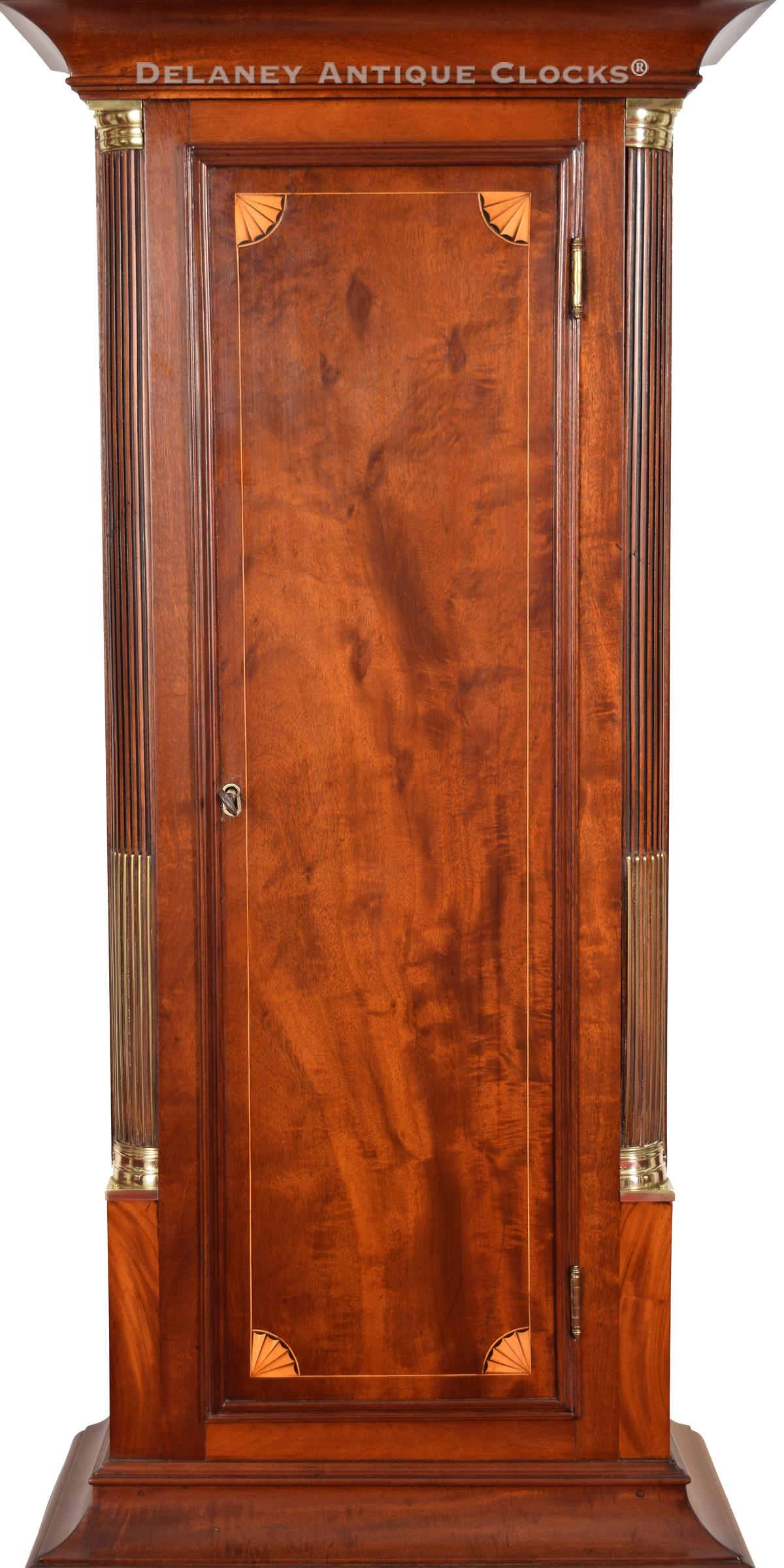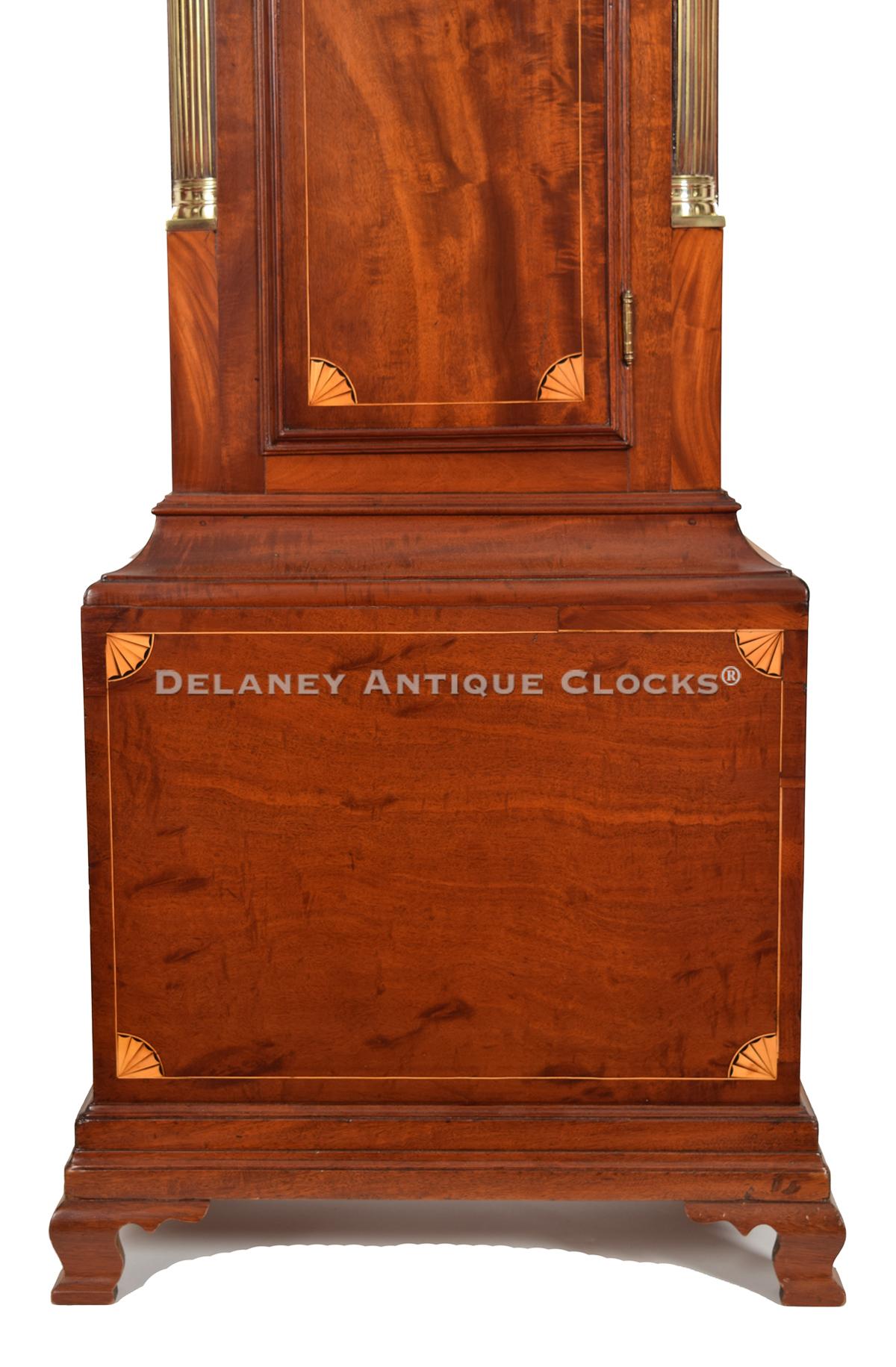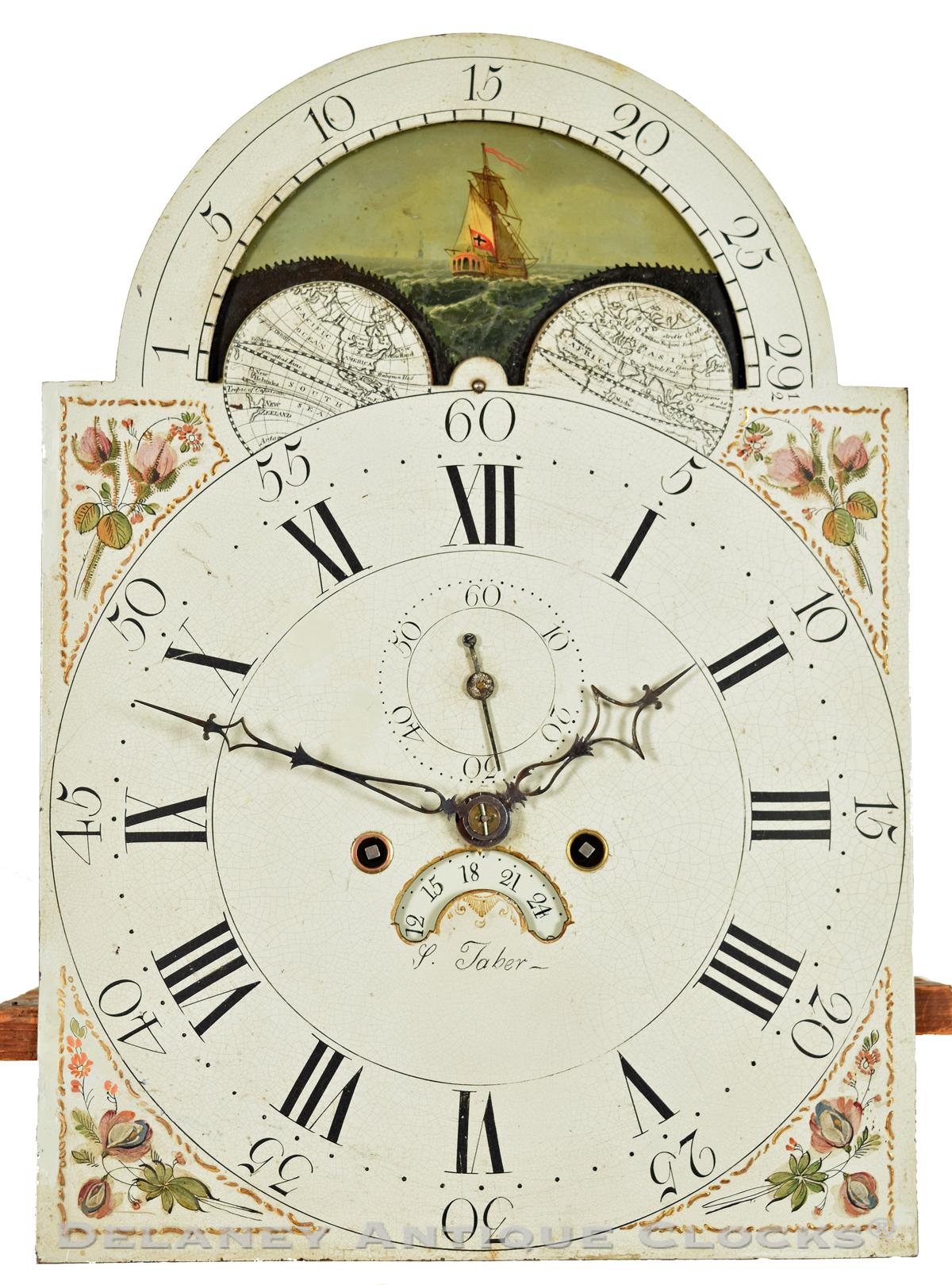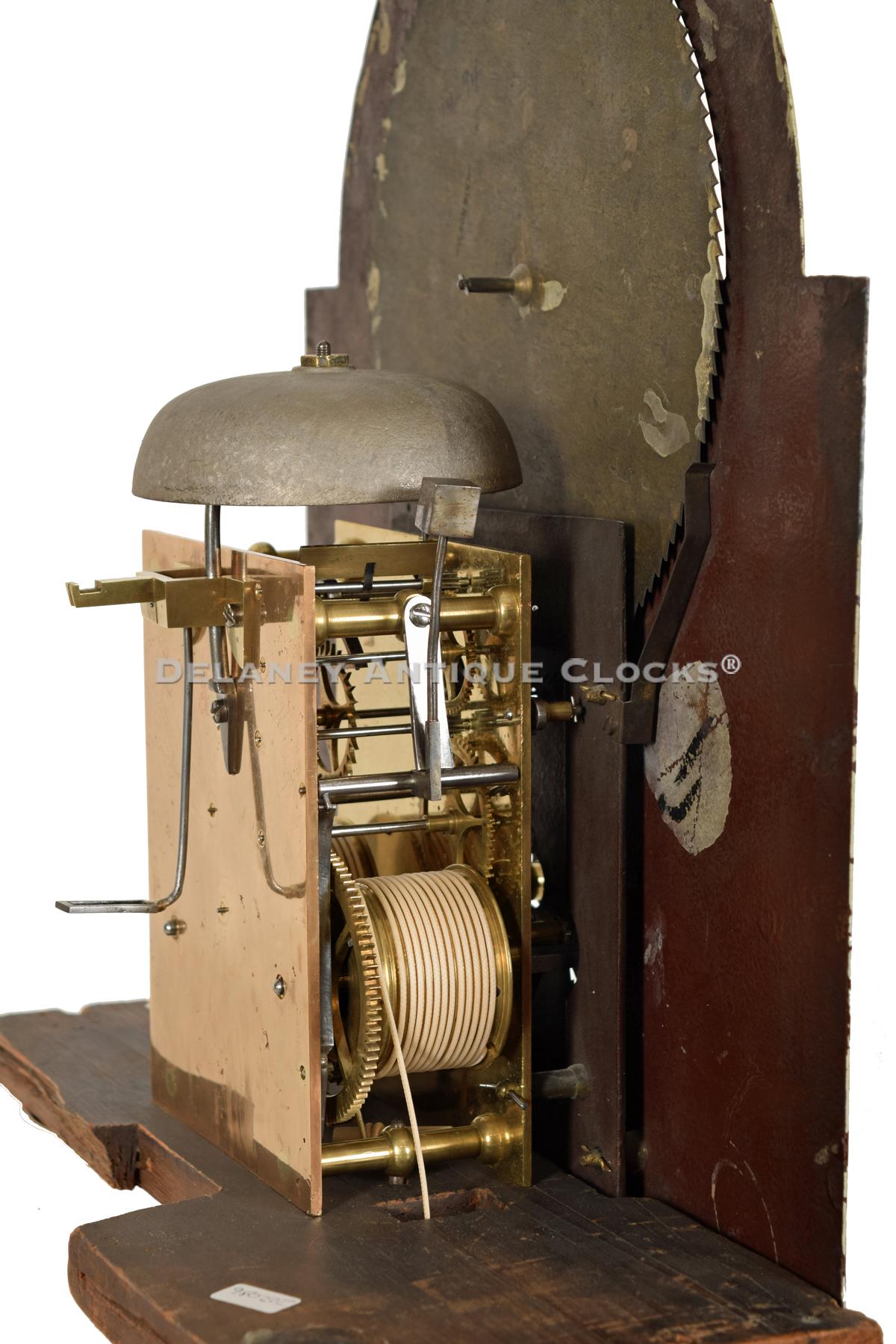This elegant, mahogany Roxbury tall-case clock was made by Stephen Taber. It boasts many desirable features, including the clock's moon-phase dial, jaw-dropping proportions, and diminutive size. 222086.
This lovely inlaid case features a modern shellac finish highlighting the exceptional quality of mahogany wood. Please note that all of the wood used in the case construction is top shelf. This includes the wood featured in the panels and the various moldings. This Boston form was made popular by the Willards during the Federal period. Stephen Taber most likely made this example before he relocated to New Bedford.
This fine example is raised on ogee bracket feet that are applied to the bottom of the base. The transition from the feet to the base panel is made by a double-step molding. The base section features a very unusual-grained selection of mahogany. This grain is reminiscent of a cross-section view of the earth's sedimentary layers. A light line inlay frames the panel. The corners of the inlaid box are fitted with inlaid quarter fans. These fans are sand shaded on one edge. This shadowing provides visual depth to this inlaid detail which is repeated in the rectangular-shaped waist door. This door features another excellent selection of veneer oriented in a vertical format. The waist door is trimmed with applied molding and opens to access the interior of the case. One can see the brass-faced pendulum bob and two drive weights through this door opening. The sides of the cabinet are fitted with fluted quarter columns. These are brass stop-fluted and terminate in brass quarter capitals. The bonnet features a pierced and open fretwork pattern, three fluted plinths, and three brass ball and spike finials. Fluted bonnet columns flank the bonnet door. These are mounted in brass capitals. The hood door opens to access a colorfully painted iron dial.
This colorfully painted dial measures 13 inches across and is signed by the clockmaker above the hour numeral six within the time track. It reads, "S. TABER." In the arch of this dial is a lunar calendar or moon phase mechanism. The lunar calendar or moon phase mechanism is a mechanical almanac. This feature was most likely made on special order due to the extra work involved in producing it. This display would have been valuable to a number of occupations during the colonial era. Farmers were known to track the moon phase to anticipate the days that offered the most available moonlight. A bright night would be more beneficial to them in scheduling the tilling and harvesting of their fields. Sailors and merchants track the lunar phases to know when the high tide would allow their ships to sail easily from the port or when the fishing might be best. Numerous religious groups had an almost superstitious litany of rituals that were best performed in accordance with lunar events. The lunar month represents an inconvenient interval of 29 days, 12 hours, 44 minutes, and 2.8 seconds. A tall clock's lunar calendar is set constant at 29.5 days which represents a full cycle. As a result, a 9-hour setback is required at the end of a single year to keep the lunar display current. The time track is formatted in a traditional manner. The hours are displayed in Roman numerals. Each of the five-minute markers and the subsidiary seconds ring is displayed in an Arabic format. This dial also displays the seconds and the date of the month.
This fine movement is constructed in brass and is of good quality. Four-turned pillars support the two brass plates. Hardened steel shafts support the polished steel pinions and brass gearing. The winding drums are grooved. The escapement is a recoil design. The movement is weight-driven and designed to run eight. It is a two-train or a time-and-strike design having a rack and snail. As a result, it will strike each hour on the hour. This is done on a cast iron bell mounted above the movement. The time and strike brass constructed movement is weight powered and designed to run for eight days. It is of excellent quality.
This clock was made circa 1798. The case is approximately 7 feet 8 inches tall to the top of the center finial. The case is 22 inches wide and 11 inches deep when measured at the bonnet molding.
Inventory number 221020.
Stephen Taber was born on October 23, 1777, in New Bedford, Massachusetts, and died there on September 10, 1862. His older brother Elnathan was nine years his senior and had moved North to Roxbury, where he served his clockmaking apprenticeship under Simon Willard. Simon considered Elnathan a highly skilled mechanic and his best apprentice. Elnathan remained in Roxbury after his indenture and continued to build clocks for himself and others in the Roxbury group of Clockmakers. Because of Elnathan's success, it is logical to assume that Stephen was also attracted to the clockmaking community in Roxbury. Stephen was trained in Boston by Aaron Willard, Simon's younger brother. By 1798, Stephen is recorded in the town of Roxbury's Tax Records as a Roxbury resident. This would suggest that he moved to Roxbury to start his apprenticeship sometime in 1791-92 at the age of 14. After serving his apprenticeship, he stayed in Roxbury for one year and returned to New Bedford in 1799. Here he advertised in October of that year that "Stephen Taber, (Late apprentice to Mr. Aaron Willard, Clock-Maker in Boston) Respectfully informs the public That he carries on the Clock Making Business... at his shop in Union Street..." From this time until he died in 1862, it appears that he lived and worked primarily in New Bedford. He is also listed as working in Acushnet for a short time. Over the later part of his life, the extent of his clockmaking trickled off as the years passed. This is assumed because he was more commonly listed as a merchant or trader by 1810. By 1860, his estate was valued at over $100,000. At the time of his death in 1862, his wealth had almost doubled. He married Elizabeth Sprague Pitcher in 1824. After he died in 1862, she became a philanthropist. She was one of the founding members of Tabor Academy in the town of Marion.




